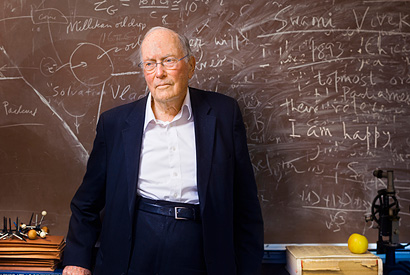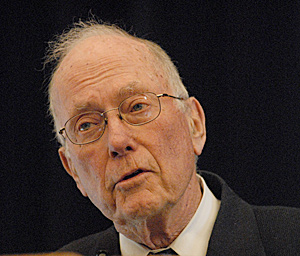Laser discoverer Charles Townes to receive first Golden Goose Award
Charles Townes, who won a Nobel Prize in Physics for invention of the laser, will receive an inaugural Golden Goose Award Sept. 13. Presented for the first time this year, the prize honors scientists who received federal funding for seemingly arcane work that turned out to have revolutionary applications.

September 11, 2012
Nearly 60 years ago, when the U.S. Navy funded Charles Townes’ work to develop an intense source of short-wavelength radiation, it was unclear what impact this would have outside Townes’ rather arcane study of atoms and molecules.

Nobel Laureate Charles Townes was investigating how light interacted with atoms and molecules when he developed the laser nearly 60 years ago. Peg Skorpinski photo.
The impact is very clear today. Thanks to that federal funding, Townes built the first maser – a device that amplified microwaves into an intense, coherent beam – and designed its more practical and now ubiquitous successor, the laser.
“(The Navy) was very generous in funding us for general work on studying molecules and atoms,” said Townes, 97, a professor emeritus of physics at the University of California, Berkeley. “They felt this very basic research was important. That’s excellent.”
In recognition of the unexpected impact of his study of molecular and atomic spectroscopy, Townes will receive an inaugural Golden Goose Award.
The recipients were announced by U.S. Rep. Jim Cooper (D-Tenn.), who conceived the award, and Dr. Alan Leshner, CEO of the American Association for the Advancement of Science (AAAS), one of the sponsors, in an essay in the Sunday, Sept. 9, edition of The Washington Post. According to Cooper, Leshner and the various national organizations sponsoring the award, the new prize “highlights the unpredictable nature of basic scientific research and the fact that some of the most important scientific discoveries come from federally funded research that may once have been viewed as unusual, odd or obscure.”
In a statement issued upon launching the award in April 2012, the organizations said the award was designed to counter criticism of seemingly frivolous but important and potentially revolutionary research funded by the federal government. The Golden Fleece Award, for example, was once routinely given out by the late Wisconsin Sen. William Proxmire to research he considered a waste of taxpayer money.
Cooper and Leshner noted in Sunday’s op-ed that while many countries, ranging from China to Germany, are ramping up funding for research and development, “In the United States … additional budget cuts have been proposed to R&D spending for non-defense areas. If budget-control negotiations fail, drastic across-the-board cuts will take effect in January that could decimate entire scientific fields.”
To prevent the United States from falling behind, they urged more funding of basic research, which they termed “the seed corn of innovation.”
“Let’s honor our modern-day explorers. We need more of them. They deserve the last laugh,” they concluded.
Townes and five co-recipients will receive the award at 5 p.m. EDT Thursday, Sept. 13, during a ceremony in the Rayburn House Office Building in Washington, D.C. The event will be hosted by Cooper, Leshner and other members of Congress.
Don’t kill the goose that laid the golden egg
“We’ve all seen reports that ridicule odd-sounding research projects as examples of government waste,” Cooper said in the April 2012 statement. “The Golden Goose Award does the opposite. It recognizes that a valuable federally funded research project may sound funny, but its purpose is no laughing matter. I hope more of my colleagues will join us in supporting, not killing, the goose that lays the golden egg.”
Townes’ co-honorees are Martin Chalfie, Osamu Shimomura – who cannot attend – and Roger Tsien, whose study of glowing jellyfish led to numerous medical advances and resulted in the researchers winning the 2008 Nobel Prize in Physiology or Medicine; and Eugene White, Rodney White and Della Roy, whose study of tropical coral led to the development of an ideal bone graft material.
Tsien was a professor at UC Berkeley from 1982 to 1989 before moving to UC San Diego.
“With the Golden Goose Award, they’re trying to recognize government-supported research that has had surprising results and encourage the government to support research where it may not be foreseeable what its results will be,” Townes said.
His research, conducted at Columbia University in New York in the 1950s, was aimed at finding a way to produce light at shorter wavelengths than was possible with the electronic devices of the era in order to study light absorption by atoms and molecules.
“(The Navy) was just letting me do microwave spectroscopy of molecules,” he said. “We had electronics which got down to about ½ centimeter wavelengths, the shortest we could produce. I wanted to get down to still shorter wavelengths, the infrared. That’s why I worked and worked and finally got the idea of a laser.”
He and colleagues James P. Gordon and H. J. Zeiger built the first maser in 1954 to prove that the concept worked, and then everyone jumped on the bandwagon. A competitor built the first laser, amplifying visible light, in 1960. Townes shared the 1964 Nobel Prize in Physics for his innovations.
Asked what he thought when he heard that he had received the Golden Goose Award, Townes chuckled. “What did I think?” he said. “I didn’t know what to think.”
Townes is still receiving federal funding from the National Science Foundation to conduct infrared observations using a three-telescope interferometer located at the Mt. Wilson Observatory in southern California. The interferometer is measuring the changes in the apparent sizes and shapes of red giant stars and the dust shells that surround them.
The founding organizations of the Golden Goose Award include AAAS, which publishes the journal Science; the Association of American Universities, a nonprofit association of 59 leading U.S. public and private nonprofit research universities and two Canadian counterparts; the Association of Public and Land-grant Universities, representing 219 public research universities, land-grant institutions and many state public university systems; the Breakthrough Institute, a liberal think tank; the Progressive Policy Institute, an independent D.C.-based think tank; the Richard Lounsbery Foundation, which supports scientific and technology research, education and policy; The Science Coalition, a non-profit, nonpartisan organization of the nation’s leading public and private research universities; the Task Force on American Innovation, a coalition that advocates for greater federal investments for basic research in the physical sciences and engineering; and United for Medical Research, a coalition that seeks steady increases in funding for the National Institutes of Health.
Other organizations sponsoring the Golden Goose Award include the Association of American Medical Colleges, the American Chemical Society and the American Mathematical Society.
RELATED INFORMATION
- Washington Post op-ed (Sept. 9, 2012)
- Golden Goose Award
- Press release announcing Golden Goose Award (PDF, April 25, 2012)
- Charles Townes honored during celebration of laser’s 50th birthday (Jan. 19, 2010)
- Nobel Prize website biography of Charles Hard Townes